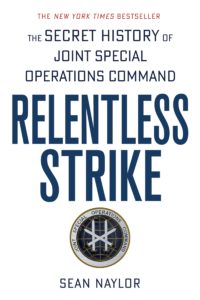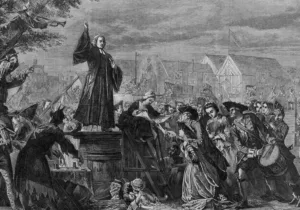This review of Sean Naylor’s Relentless Strike: The Secret History of Joint Special Operations Command first appeared in the Fall 2016 issue of Providence‘s print edition. To read the original in a PDF format, click here. To receive complete copies of future issues before articles appear online, click here.
One reason generals are so often said to be prepared to fight the last war is that immense resources have been expended to bring their forces into that configuration, and the politicians who are their masters have no wish to raise similar amounts to alter those forces substantially. And if they were willing to do so, what military contingency should they prepare for? They have no particular talent for predicting the future, and neither do the generals who advise them. That was no disadvantage in the First Gulf War because defending against an armor-heavy assault was the basic assignment of the U.S. Army’s Seventh Corps in Europe. Once the Corps was transported from Germany to the Middle East, it was for the most part already trained and equipped to fight the new and unexpected foe.
 All this changed after the 9/11 attacks on the American homeland. With the Al Qaida perpetrators under Taliban protection in Afghanistan, large infantry formations and heavy armor didn’t seem to be what was needed; again we were prepared to fight the last war. Two years later the legacy U.S. military made short work of the Saddam Hussein regime, but it didn’t serve as well to battle the ensuing insurgency.
All this changed after the 9/11 attacks on the American homeland. With the Al Qaida perpetrators under Taliban protection in Afghanistan, large infantry formations and heavy armor didn’t seem to be what was needed; again we were prepared to fight the last war. Two years later the legacy U.S. military made short work of the Saddam Hussein regime, but it didn’t serve as well to battle the ensuing insurgency.
Any competent military or paramilitary force not well prepared for its current assignment will make the best use of whatever assets it possesses. Woefully outmatched in transport, aviation, and weaponry, as well as numerous other military assets, the Taliban in Afghanistan and Al Qaida in Iraq resorted to classic guerrilla tactics—propaganda, blending in with the population, ambushes, mines and booby traps, and intimidation of civilians—in order to secure sustenance and prevent cooperation with government and allied forces. With conventional forces and tactics offering limited effectiveness against the insurgencies, American and allied forces fell back on one of their own strengths: the unconventional forces that the various services had created to deal with past conflicts.
Sean Naylor’s excellent study shows how the U.S. military services organized (or reorganized) themselves to counter the guerrillas that too often were able to evade regular units and strike their vulnerabilities. This work is primarily an organizational study in which the reader learns about each component’s contribution to the whole special operations effort. The overall command and control headquarters is called the Special Operations Command (SOCOM) with the field forces coming under a headquarters known as the Joint Special Operations Command (JSOC). “Joint” refers to the meshing of forces in the field from Army, Navy, and Air Force organizations.
Within each service, different components contributed to special operations from different and sometimes competing formations, often adapted from earlier organizations in the respective services. The Army’s 75th Ranger Regiment traces its lineage back to the eighteenth century; the Navy Seals to the Underwater Demolition Teams of World War II; Army Special Forces were a cold war invention intended to organize and train indigenous guerrilla groups in countries coming under control of the Warsaw Pact. The Army’s Delta Force and the Navy’s Seal Team Six were newer organizations developed to deal with the exigencies of hostage-taking and Islamist terror operations. But these disparate services exercised their “jointness” in so many operations that those lines of origin became blurred. Thus the force that killed Osama Bin Laden was from Team 6, even though there was no maritime element in the operation. Rangers, who were essentially highly trained light infantry, came to participate and even lead intricate and highly dangerous raids that were the forte of Delta and Team 6 “operators.”
It may seem churlish to complain of gaps in so comprehensive and competent a study, but I cannot help but mention Naylor’s apparent lack of interest in the ethical dilemmas. These issues inevitably loom large when warriors are in combat directed against an enemy that operates in the midst of and under cover of women and children, and uses houses of worship for military purposes, deliberately to deter effective fire against themselves. He does write about the rules of engagement that govern allied tactics, but he seems to regard them as obstacles that special operations units must cope with, or pragmatic tools to avoid frustrating their mission by turning the civilian populations toward helping the enemy. He also writes in detail about numerous assassinations and the tactics that led up to them, without considering the ethical implications.
There is at least one other important moral issue that receives short shrift in this volume, and that is the treatment of prisoners. Waterboarding and other harsh techniques were a dominant feature of debate in the American press and between politicians—and therefore hazardous to the continuation of Special Operations. It would have been useful to read an exposition of the tradeoffs between accomplishing the mission without unacceptable losses on the one hand and jeopardizing its continuation through political and public opposition on the other.
A section on recruiting and training these specialized warriors to do their dangerous work would also have been a welcome addition to this book. Perhaps Naylor will have more on this for us in the future. The book under review reveals him as a skillful analyst and writer, and he has now amassed such a significant body of knowledge that it would be a shame not to make further use of it.
Finally, the reader of this review should be aware that many of Naylor’s sources are “a former Team 6 member,” “a retired Delta operator,” and the like. This makes for a more engrossing book, but we cannot know how many of these testimonies are more in the nature of self-justification or settling scores than they are the imparting of information. The final account of these events is probably several generations in the future.
—
Herbert Schlossberg is a retired historian. He is a former infantryman in the 82nd Airborne Division.
Photo Credit: Navy SEAL demonstrates winter warfare capabilities in Mammoth Lakes, California on December 9, 2014. Photo provided by Naval Special Warfare Command via DVIDS.






 Sponsor a student for Christianity & National Security 2024
Sponsor a student for Christianity & National Security 2024